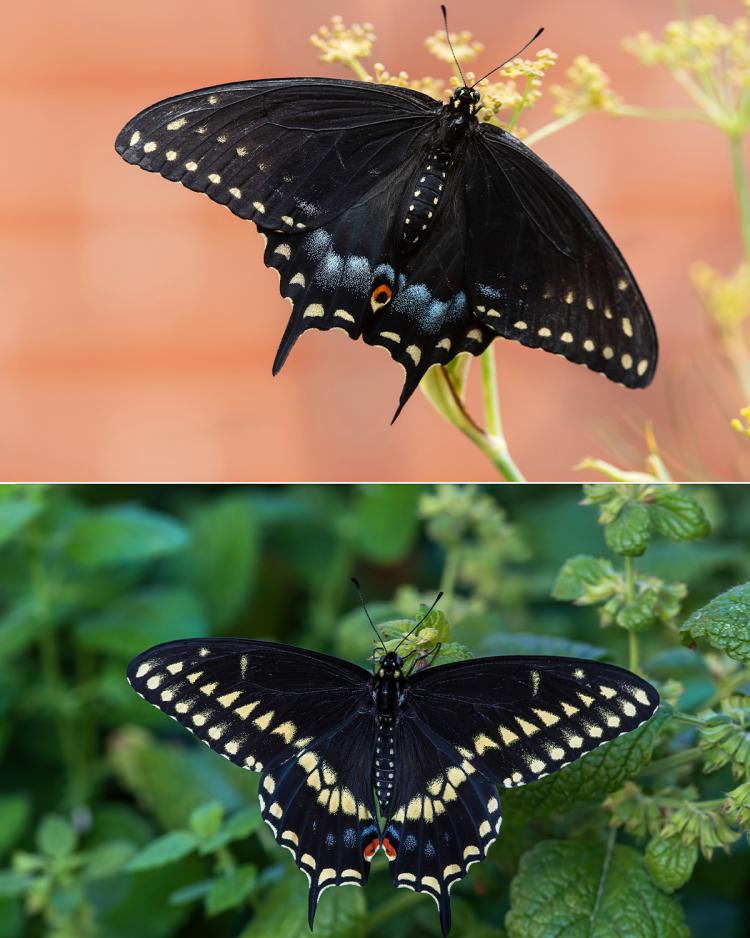The Darwin Award goes to a male black swallowtail butterfly
The beautiful male emerged in October, eager to mate but destined for disappointment because he emerged too late in the season, just an example of natural selection at work
I received an invitation to photograph a black swallowtail butterfly that had just emerged. It would linger only a short while before emerging, so I hurried over. The date was Oct. 13.
The black swallowtail, Papilio polyxenes, had bright colors and was just gorgeous. Males and females have the same colors and patterns ventrally but their dorsal patterns distinguish the genders. All have orange, yellow and black eye spots, but males have two prominent lines of yellow spots and a light dusting of blue spots, while females have much less yellow and much more blue. This was a male.
I hereby award this male black swallowtail the Darwin Award. While the idea of the Darwin Award reaches back into the mid-1980s, the Award matured around 1993, when Wendy Northcutt, then a graduate student at the University of California Berkeley, established the website "darwinawards.com."
The Darwin Award is a facetious award to people—almost all men—who have improved the gene pool of the next generation by outrageous, idiotic behavior that resulted in their death, and thereby prevented them from passing their genes on to the next generation.

A beautiful male emerged in October, eager to mate but destined for disappointment. Photos by Jeff Mitton.
I am taking a liberty by awarding the prize to an animal, but Northcutt established the animal precedent in 2018 by awarding it to male wooly mammoths. The male swallowtail exhibited foolishly impatient behavior, given that the goal of a male black swallowtail is to mate with as many females as possible. I fear that he did not see another black swallowtail and died a lonely bachelor without siring any offspring.
Black swallowtail pupae overwinter in a chrysalis and emerge in spring. Around Boulder, adults will be flying in May, June and July. The average longevity of the adult form is 14 days, so adults disappear by the end of August. This male emerged in mid-October and was probably the only black swallowtail in Boulder.
His lack of offspring is a dead end for his genes, both beneficial and detrimental. The fitness or success of a genotype is measured by its number of offspring. If his tragically early emergence had a genetic component, this is the mechanism by which detrimental genes are selected against—detrimental genes suppress reproductive success.
This is natural selection, and it is called natural selection because it is not planned, directed or orchestrated by anything other than weather, climate, competition, disease and predation.
Risky or detrimental actions that we describe as poor choices are not uncommon. One that captured widespread news coverage a few years ago was the discovery that three young gray whales had been found trapped by pack ice near Point Barrow, Alaska. No one knows what events led to their separation from their pod and the elders who would have led them south to mating grounds in Mexico.
Thanks to legions of eager bird watchers, we have many examples of vagrants, defined as birds that deviated from established routes of migration. Point Reyes in northern California, because of its geographic location, concentrates birds that are wandering aimlessly, as well as birds whose directional compass is not precisely calibrated, or is precisely mis-calibrated (e.g., directing flight 40 degrees west of south, rather than east of south). Each year, hundreds of vagrants from dozens of species are documented.
A vagrant that caught a lot of attention was a Steller's sea eagle, a resident of east Asia. It was out of its normal range when this large and distinctive bird was seen over the Denali Highway two years ago. Later, it was spotted in southern Texas, then Canada, New England and finally Nova Scotia in April of this year.
Many other examples are documented. The majority of the vagrant wanderers are doomed to a lonely death with a fitness of zero. Genes leading to inappropriate migration routes are removed from the gene pool each and every year.
Sexual reproduction involves replication of the genes to be packaged in sperm and eggs. DNA replication is quite accurate, but genomes are so large that errors—called mutations—occur regularly.
For example, each human is estimated to carry 70 to 200 new mutations. Accumulation of deleterious mutations is opposed by natural selection, which is necessarily relentless. Some mutations promote self-destructive actions so silly that they are celebrated with a Darwin Award.

